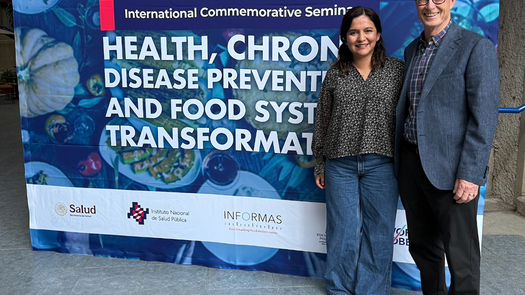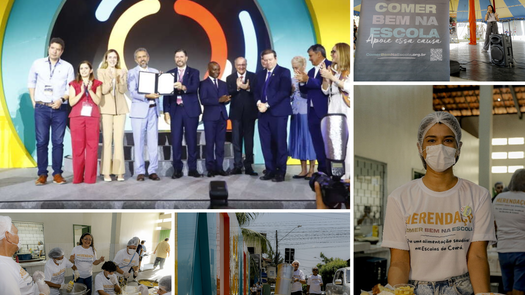November 25, 2025
In 2001, Brazil was one of the first countries in the world to consider mandatory nutrition labeling. Nutrition labels provide information that can help consumers make informed (and potentially healthier) choices about the food they purchase and consume. It was one of the actions defined for the implementation of the Brazilian National Food and Nutrition policy. In Brazil, nutrition labels are regulated by Anvisa, Brazil’s National Health Surveillance Agency, an autarchy linked to the Ministry of Health.
The regulatory review process of the nutrition labels began in 2016. From the beginning, some food and beverage industry sectors tried to water down the regulations. The Brazilian Institute for Consumer Protection (IDEC), a leading consumer defense organization in Brazil, ramped up its advocacy efforts, building public support on the need for clearer and more informative labels. They recognized it was important for civil society to become organized and consistent in their efforts to face the food and beverage industry and push back on their interference in healthy food policies. These efforts culminated with the new regulation (RDC 429/2020), approved in October 2020. This regulation went into effect earlier last month (October 9, 2022) and it includes a mandatory front-of-package warning label (FOPL) for products with high levels of sugar, saturated fats and sodium. You can read an English summary of the final FOPL regulation here.
The Global Health Advocacy Incubator (GHAI) spoke with Brazilian partners Laís Amaral Mais (Technical Supervisor) and Janine Giuberti Coutinho (Coordinator) at IDEC’S Healthy and Sustainable Food Program about this new regulation to learn more about how it’s being implemented and what comes next for advocates in Brazil for FOPL.
What was IDEC’s approach to create a favorable environment for FOPL regulation? How did IDEC and civil society have to pivot and adapt when the political environment became more challenging?

IDEC demonstrated to Anvisa the need to improve the nutritional labeling standard to ensure clear and adequate information for consumers. Following the recommendations of the National Council for Food and Nutrition Security (Consea) and discussions within Mercosur, a regional trade bloc, civil society was able to prompt a favorable environment which pushed Anvisa to include the issue in its regulatory agenda and culminated with the creation of a working group to discuss the rules. IDEC maintained the favorable environment and advanced the process by establishing evidence free of conflict of interests, creating awareness of the problem and pressuring Anvisa to be transparent along the process through advocacy efforts.
IDEC faced challenging political and social situations, including the Temer and Bolsonaro administrations – who were strongly aligned with the food and beverage industry and the private sector – and COVID-19. Demonstrating the region’s advances on FOPL, IDEC showed Anvisa, and Brazilians, the importance of finalizing the regulatory process in Brazil. Anticipating potential industry interference, IDEC mapped out possible scenarios for the FOPL regulation. For example, during the pandemic it was necessary to use judicial means to ensure completion of the process, which occurred through a lawsuit produced by IDEC.
Could you comment on what the industry interference was like during this process and whether it has changed over the years?
Industry interference occurred throughout the regulatory process through different corporate political actions. In the beginning, the industry created a coalition (Rede Rotulagem or Labeling Network) of agribusiness industry associations and ultra-processed products to be its public face. Rede Rotulagem acted to establish a link between society and the press through social networks, website, interviews, events and evidence production with clear conflicts of interest. The industry was part of all stages of technical and political discussions, with participation in the Anvisa working group, sector dialogues, public consultations, discussions at international level (such as Mercosur and Codex Alimentarius) and meetings with the technical team and directors of Anvisa. Industry directly lobbied the then President, Michael Temer, to appoint an Anvisa director who would act on behalf of industries and legal action was used to delay the progress of the regulatory process.

The agribusiness sector only appeared more prominently at the end of the process, requesting a deadline extension for sending contributions to the 2019 public consultation. The sector argued that the regulatory measure would only harm the economy and consumer’s freedom of choice. It also argued that an FOPL regulation wouldn’t make a difference without education and information for consumers and that problem isn’t the diet but the need for exercise.
Initially, the industry advocated for a FOPL model in the form of a traffic light symbol. But as pressure mounted from civil society calling for a “high in” warning label during public consultations, the industry pivoted and presented another model. It was a weaker version of the label being proposed by Anvisa at the time (a magnifying glass), with much smaller dimensions and focused on a weaker nutrient profile that identified a minor number of foods as “high in” sodium, saturated fat and sugars. An evidence based description of industry interference in the regulatory process can be found in the Big Food Dossier, recently launched by IDEC in partnership with ACT Health Promotion.
What are the strengths and weaknesses of the approved nutrition labeling regulation in Brazil? What changes and improvements need to happen to strengthen the policy and protect public health?
Some of the strengths of the new labeling regulation include the eligibility criteria for products that may receive a warning label, which focus on ultra-processed products and excludes fresh and minimally processed foods, and the choice of a black and white “high in” label to be placed on the top of the package. The regulation also prohibits placing other labeling models next to the magnifying glass label and using nutrition claims of the same nutrients the FOPL warns. In addition to the FOPL, the regulation also mandates that the nutritional facts table includes information per 100g or 100ml (which favors comparisons among products content) on total and added sugars, as well as a standardized table design for all packages with a specific font and size and black letters on a white background.
Some of the challenges imposed by the standard include the size of the label (smaller than what was indicated by studies); the approved nutrient profile model which will no longer label some of the unhealthy ultra-processed products and is weaker than what evidence supports; and the absence of FOPL for added sweeteners, which will most likely result in the reformulation of products. IDEC/civil society initially advocated for a warning model in the shape of a triangle that highlights the high presence of nutrients of concern like sodium, sugar and fat. It is important to know that FOPL models are supported by the World Health Organization and the Pan American Health Organization because evidence shows they are the most effective to shift purchase intentions to healthier choices.

What comes next for the food labeling agenda in Brazil?
To understand the food industry and consumers’ response to the new standard, studies are needed to monitor and evaluate the implementation. IDEC knows that it is essential to improve the nutrient profile model chosen by Anvisa and proposed using the nutrient profile model recommended by PAHO, which more accurately determines the products that should have the FOPL and, thus, should have their consumption avoided.
Brazil also needs to move forward on regulatory measures linking FOPL to other healthy policies, such as marketing restrictions, sugar-sweetened beverage taxation and availability and restriction in specific environments, such as schools.
Additionally, information on the presence of added sweeteners is necessary and urgent. Consumers have the right to know what they are consuming, and based on Chile’s experience, we know that the industry may increase the use of added sweeteners because of the magnifying glass label that includes “high in sugar.”
Advocates in Brazil will be closely monitoring the implementation of the front of package warning labels and will continue to push for its improvement. In the meantime, Brazilian consumers are one step closer to understanding which products have high levels of concerning ingredients like sugar, sodium and fat.



